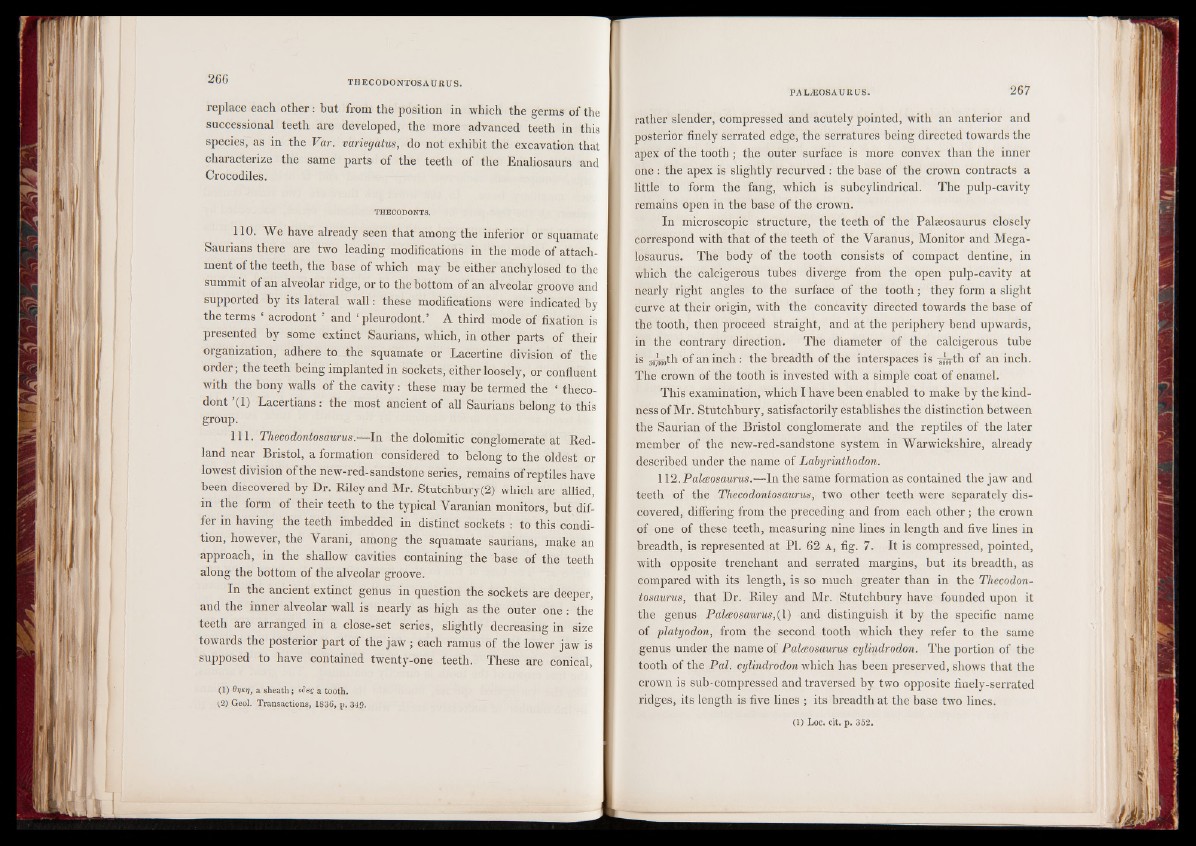
replace each other : but from the position in which the germs of the
successional teeth are developed, the more advanced teeth in this
species, as in the Var. variegatus, do not exhibit the excavation that
characterize the same parts of the teeth of the Enaliosaurs and
Crocodiles.
THECODONTS.
110. We have already seen that among the inferior or squamate
Saurians there are two leading modifications in the mode of attachment
of the teeth, the base of which may be either anchylosed to the
summit of an alveolar ridge, or to the bottom of an alveolar groove and
supported by its lateral wall: these modifications were indicated by
the terms ‘ acrodont 5 and ‘ pleurodont.’ A third mode of fixation is
presented by some extinct Saurians, which, in other parts of their
organization, adhere to the squamate or Lacertine division of the
order; the teeth being implanted in sockets, either loosely, or confluent
with the bony walls of the cavity: these may be termed the ‘ thecodont
(1) Lacertians: the most ancient of all Saurians belong to this
group. 111. Thecodontosaurus.—In the dolomitic conglomerate at Red-
land near Bristol, a formation considered to belong to the oldest or
lowest division of the new-red-sandstone series, remains of reptiles have
been discovered by Dr. Riley and Mr. Stutchbury(2) which are allied,
in the form of their teeth to the typical Varanian monitors, but differ
in having the teeth imbedded in distinct sockets : to this condition,
however, the Varani, among the squamate saurians, make an
approach, in the shallow cavities containing the base of the teeth
along the bottom of the alveolar groove.
In the ancient extinct genus in question the sockets are deeper,
and the inner alveolar wall is nearly as high as the outer one : the
teeth are arranged in a close-set series, slightly decreasing in size
towards the posterior part of the jaw ; each ramus of the lower jaw is
supposed to have contained twenty-one teeth. These are conical,
(1) 9r)Kt), a sheath; oSeg a tooth.
1.2) Geol. Transactions, 1836, p. 349. 1
rather slender, compressed and acutely pointed, with an anterior and
posterior finely serrated edge, the serratures being directed towards the
apex of the tooth ; the outer surface is more convex than the inner
one : the apex is slightly recurved: the base of the crown contracts a
little to form the fang, which is subcylindrical. The pulp-cavity
remains open in the base of the crown.
In microscopic structure, the teeth of the Palseosaurus closely
correspond with that of the teeth of the Yaranus, Monitor and Mega-
losaurus. The body of the tooth consists of compact dentine, in
which the calcigerous tubes diverge from the open pulp-cavity at
nearly right angles to the surface of the tooth; they form a slight
curve at their origin, with the concavity directed towards the base of
the tooth, then proceed straight, and at the periphery bend upwards,
in the contrary direction. The diameter of the calcigerous tube
is soVooth of an inch : the breadth of the interspaces is -g^-tb of an inch.
The crown of the tooth is invested with a simple coat of enamel.
This examination, which I have been enabled to make by the kindness
of Mr. Stutchbury, satisfactorily establishes the distinction between
the Saurian of the Bristol conglomerate and the reptiles of the later
member of the new-red-sandstone system in Warwickshire, already
described under the name of Labyrinthodon.
112. Paleeosaurus.—In the same formation as contained the jaw and
teeth of the Thecodontosaurus, two other teeth were separately discovered,
differing from the preceding and from each other; the crown
of one of these teeth, measuring nine lines in length and five lines in
breadth, is represented at PI. 62 a , fig. 7. It is compressed, pointed,
with opposite trenchant and serrated margins, but its breadth, as
compared with its length, is so much greater than in the Thecodontosaurus,
that Dr. Riley and Mr. Stutchbury have founded upon it
the genus Palceosaurus,(\) and distinguish it by the specific name
of platyodon, from the second tooth which they refer to the same
genus under the name of Palceosaurus cylindrodon. The portion of the
tooth of the Pal. cylindrodon which has been preserved, shows that the
crown is sub-compressed and traversed by two opposite finely-serrated
ridges, its length is five lines ; its breadth at the base two lines.
(1) Loc. cit. p. 352.